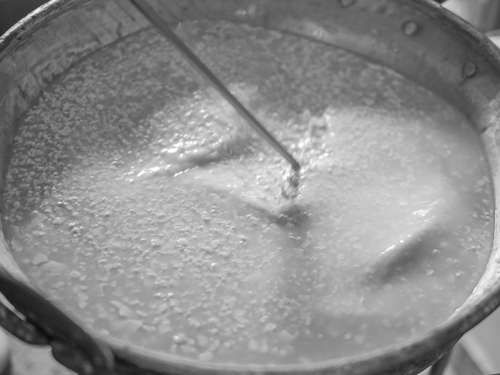We went to the home of the Sándor family in the town of Homoródalmás. As is common in this part of Romania, there was a large wooden gate and a high fence, which separated the property from the outside. Having entered, we were told that the former farmhouse had been converted to a guesthouse, while the barn had been turned into a farmhouse, a dairy and a farm shop.
Inside the dairy, Huba and his girlfriend were working, he was making cheese, while she was cleaning, an indispensable task in any kind of food preparation.
There was one small copper kettle full of milk and one middle-sized copper kettle, which was empty, and a big stainless steel kettle also full of milk.Actually, the milk and already been turned into curd and after having cut it up and collected the cheese mass, Huba went on to remove whey, He laid a cylinder-shaped sieve in the whey, then he used a siphon to let it flow out of the container into a plastic container. By removing whey at the same time as he was making cheese, he saved natural gas used for heating the curd. Later, Huba would fill his car with plastic containers full of whey, next we would follow him pour the whey into troughs to feed the 35 Mangalitsa pigs of the Sándor family.
This farm is being run by three generations of the Sándor family, but it’s Huba who took the initiative to build the dairy. They have 5 goats and 30 sheep and they buy goat’s milk from a shepherd who has 100 goats, but no car, making it easier for him. Besides, they have 25 dairy cows, 50 including calves. The cows are grazing together with cows owned by three other persons and the Sándor family buys cow’s milk from all of them.Huba has a barn at his grandparents’ house, but he is building another one outside town because the townspeople don’t want cows in the town. Besides cheesemaking and feeding the pigs, which more or less manage themselves, he also has to look after the cows and calves.
Huba started selling milk to dairies, but they paid next to nothing. Next, he went to some cheesemaking courses and he practised cheesemaking in two small dairies in Hungary, then he went back here.
During our visit, we could watch Huba separate cheese mass from the whey and put the former in large, cylindrical and porous plastic containers. Then, he pressed out as much whey as possible, next he put weights on them to squeeze out even more whey. He also released cheeses, which had been made the day before, from the plastic containers. One of the cheeses wouldn’t let go and he had to bend, push and pull the container vigorously before the cheese fell down on a bench.
Having finished cheesemaking and watching Huba’s girlfriend lighting a fire below the copper kettle in order to heat the milk to about 40°C, we went to the pigs which were inside a large pen on the outskirts of the town. First, he called them and they came running in anticipation of something to eat. Then, he threw some handfuls of cereals inside the pen and the pigs started eating them at once. He opened the fence and poured whey into several troughs, from which the pigs starting drinking by slurping heavily. The big male pig pushed the other pigs aside in order to get a place at the trough although there was more than enough for everyone. After having sated themselves, some of them lay down on the ground and fell asleep.
Huba told us that the pigs are outside all year, they have small houses with hay on the ground where they can sleep. The pigs are feral and dangerous and we shouldn’t enter the pen. He also told us about a man who entered a pig pen and was surrounded by Mangalitsa pigs, which cut his calf, but fortunately he wasn’t injured seriously. They are furry and independent animals and they like being scratched on the back as we could see when Huba scratched one of them on the back..
The male pigs need to be castrated and let in peace for 3 months before they can be slaughtered, else the meat will taste badly. The pigs grow slowly and they slaughtered after 2-3 years. His father makes bacon, hams, sausages and cold cuts from the pigs’ meat.
After we returned to the dairy, Huba’s girlfriend had separated the curd in the copper kettle into cheese mass, which she had put into porous, cylindrical plastic containers and whey,.
Next, we went into the storeroom where could see cheeses filled with herbs like thyme and basil, some cheeses, which had been stored in dregs in order to give them a reddish surface, some white, soft cheeses and some yellow ones. All was stored on wooden shelves.
Huba told us that goat’s milk was prepared in the small copper kettle, sheep’s milk in the medium copper kettle and cow’s milk in the large, stainless steel one. When the milk is turned into curd, the copper releases the curd easily, while steel holds it back. A little copper is dissolved in the milk, preventing bad bacteria from multiplying. Copper kettles must be cleaned regularly, else they will tarnish.
After the morning’s activities in the dairy were finished, Huba invited us to the guesthouse where we were served a selection of his excellent cheeses together with yogurt and Romanian red wine. Life is good at such times! There, he told us that he prefers to sell his family’s products at local markets and at a farmers’ market in Bucharest.
Finally, we went to the farm shop located next to the dairy. A group of Hungarian tourists were shopping cheese when we arrived, but after some time my cheese-loving guide could buy two big pieces of delicious cheese.

